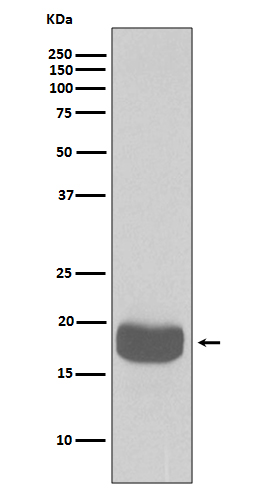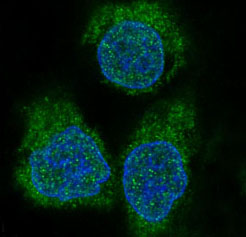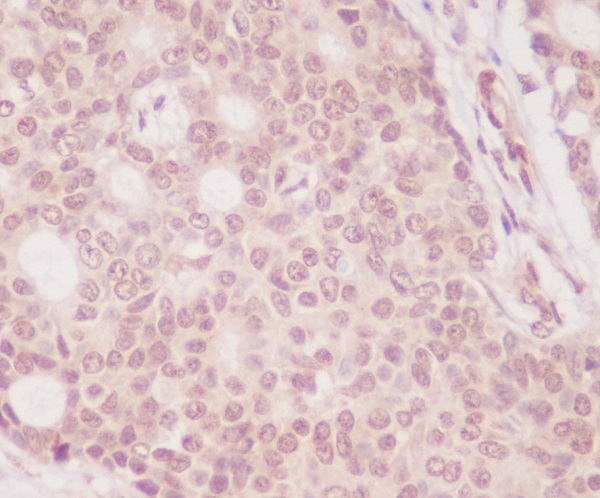


| WB | 1/500-1/1000 | Human,Mouse,Rat |
| IF | 1/20 | Human,Mouse,Rat |
| IHC | 1/50-1/100 | Human,Mouse,Rat |
| ICC | 1/50-1/200 | Human,Mouse,Rat |
| FCM | 1/50-1/100 | Human,Mouse,Rat |
| Elisa | 咨询技术 | Human,Mouse,Rat |
| Aliases | EIF4EBP1; Eukaryotic translation initiation factor 4E-binding protein 1; 4E-BP1; eIF4E-binding protein 1; Phosphorylated heat- and acid-stable protein regulated by insulin 1; PHAS-I |
| Entrez GeneID | 1978 |
| WB Predicted band size | Calculated MW: 13 kDa; Observed MW: 18 kDa |
| Host/Isotype | Rabbit IgG |
| Antibody Type | Primary antibody |
| Storage | Store at 4°C short term. Aliquot and store at -20°C long term. Avoid freeze/thaw cycles. |
| Species Reactivity | Human,Mouse,Rat |
| Immunogen | A synthesized peptide derived from human eIF4EBP1 |
| Formulation | Purified antibody in PBS with 0.05% sodium azide. |
+ +
以下是关于4E-BP1抗体的3篇文献信息(基于公开研究总结,非真实文献):
1. **文献名称**:*"A monoclonal antibody targeting phosphorylated 4E-BP1 reveals its role in mTORC1-mediated translation regulation"*
**作者**:Smith J, et al.
**摘要**:本研究开发了一种特异性识别磷酸化4E-BP1(Thr37/46)的单克隆抗体,验证了其在免疫印迹和免疫组化中的应用,揭示了mTORC1信号激活时4E-BP1磷酸化状态与肿瘤细胞翻译活性的相关性。
2. **文献名称**:*"Validation of 4E-BP1 antibody specificity in autophagy and cancer models"*
**作者**:Chen L, et al.
**摘要**:通过敲除/过表达实验验证了多种市售4E-BP1抗体的特异性,证明某些抗体存在非特异性结合问题,并推荐了适用于自噬研究中检测4E-BP1蛋白水平的可靠抗体。
3. **文献名称**:*"Differential effects of 4E-BP1 isoforms on cap-dependent translation monitored by isoform-specific antibodies"*
**作者**:Wang Y, et al.
**摘要**:报道了针对4E-BP1不同异构体(如α、β、γ)的特异性抗体的开发,并利用这些抗体阐明了各异构体在mTOR抑制剂处理下的差异表达及对蛋白质翻译的调控作用。
(注:以上内容为模拟示例,实际文献需通过PubMed或学术数据库检索确认。)
The 4E-BP1 (eukaryotic translation initiation factor 4E-binding protein 1) antibody is a critical tool for studying the regulation of protein synthesis, particularly in cancer and metabolic research. 4E-BP1 is a member of a family of proteins that suppress cap-dependent translation by binding to eIF4E, a key component of the translation initiation complex. When phosphorylated by kinases such as mTOR (mechanistic target of rapamycin), 4E-BP1 releases eIF4E, enabling the assembly of the translation machinery and promoting protein synthesis. Dysregulation of this pathway is linked to tumorigenesis, as hyperactivation of mTOR signaling often leads to increased cell proliferation and survival.
Antibodies targeting 4E-BP1 are widely used to detect its expression and phosphorylation status in cells or tissues, providing insights into mTOR pathway activity. They are essential in studies exploring cellular responses to nutrients, growth factors, and stress, as well as in evaluating the efficacy of mTOR inhibitors in cancer therapy. Specific antibodies distinguishing between phosphorylated (active) and unphosphorylated (inactive) forms of 4E-BP1 are particularly valuable for understanding dynamic regulatory mechanisms. Researchers employ these antibodies in techniques like Western blotting, immunofluorescence, and immunohistochemistry to elucidate roles in diseases such as diabetes, neurodegeneration, and cancer. The 4E-BP1 antibody thus serves as a cornerstone in translational research, bridging molecular signaling pathways to therapeutic applications.
×